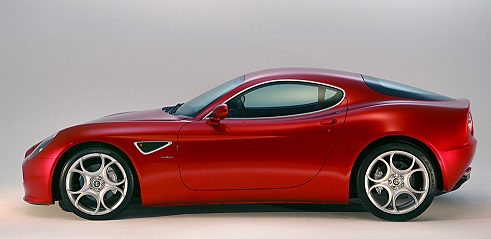

Coupe, 2 Doors, 2 Seats
15.8 l/100 km 14.89 US mpg
450 Hp @ 7000 rpm.
95.9 Hp/l
4691 cm3
286.26 cu. in.
8, V-engine
Rear wheel drive,
4381 mm
172.48 in.
1894 mm
74.57 in.
#N/D
| Brand | Alfa Romeo |
|---|---|
| Model | 8C Competizione (Coupe) |
| Version | 8C Competizione |
| Engine version | 4.7i V8 32V (450 Hp) |
| Year production start | 2007 |
| Year production end | 2010 |
| Vehicle type | Coupe |
| Horsepower RPM | 450 Hp @ 7000 rpm. |
| Acceleration 0 - 100 kmh sec | 4 sec |
| Overall length mm - inch |
4381 mm172.48 in. |
| Doors | 2 |
| Designation model | F136 YC |
|---|---|
| Cam configuration | DOHC |
| Engine position and orientation | Middle, Longitudinal |
| Cylinders | 8 |
| Position of cylinders | V-engine |
| Displacement (liters) |
4691 cm3286.26 cu. in. |
| Eng. horsepower RPM | 450 Hp @ 7000 rpm. |
| Horsepower per litre | 95.9 Hp/l |
| Torque Nm RPM lb-ft RPM |
480 Nm @ 4750 rpm.354.03 lb.-ft. @ 4750 rpm. |
| Compression ratio | 11.25 |
| Fuel delivery system | Multi-point indirect injection |
| Fuel type | Petrol (Gasoline) |
| Valvetrain | 4 |
| Engine aspiration | Naturally aspirated engine |
| Engine oil liters | quarts |
9.0 l9.51 US qt | 7.92 UK qt |
| Engine coolant |
12.5 l13.21 US qt | 11 UK qt |
| Emission certification | Euro 4 |
| Drive configuration | Rear wheel drive |
|---|---|
| Transmission | 6 |
| Front brakes | Ventilated discs, 380x32 mm |
|---|---|
| Rear brakes | Ventilated discs |
| Brake control | Ventilated discs |
| Anti-lock brake system | ABS (Anti-lock braking system) |
| Steering type | Steering rack and pinion |
|---|
| Wheels size | 285/35 ZR20 |
|---|
| Passengers seats | 2 |
|---|
| Overall length mm - inch |
4381 mm172.48 in. |
|---|---|
| Overall width mm -inch |
1894 mm74.57 in. |
| Overall height mm -inch |
1341 mm52.8 in. |
| Gross weight kg -lbs total |
1585 kg3494.33 lbs. |
|---|---|
| Fuel tank liters | gallons |
90 l23.78 US gal | 19.8 UK gal |
| Combined l/100 km - Mpg |
15.8 l/100 km14.89 US mpg |
|---|---|
| Autonomy km (combined use) | 600 |
8 CYLINDER V-Engine
https://www.thecarspec.net/components/engine/8-cylinders-v